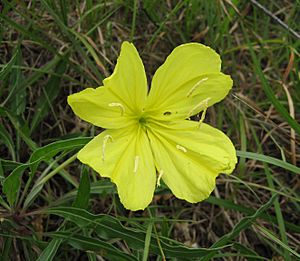Oenothera macrocarpa facts for kids
Quick facts for kids Oenothera macrocarpa |
|
|---|---|
 |
|
| Scientific classification | |
| Genus: |
Oenothera
|
| Species: |
macrocarpa
|
The Bigfruit Evening Primrose (also known as Oenothera macrocarpa) is a beautiful flowering plant. People sometimes call it the Ozark Sundrop or Missouri Evening Primrose. It belongs to the evening primrose family, Onagraceae. You can find this plant growing naturally in Mexico and the south-central parts of the United States. It likes to grow in rocky, lime-rich areas like prairies and limestone cliffs.
Contents
What Does It Look Like?
This plant is a type of perennial herb. This means it has soft stems and comes back year after year. Its stems are reddish and grow about 6 to 12 inches (15 to 30 cm) tall.
The flowers are large, about 3 inches wide, and shaped like a cup. They are a bright canary yellow color and have a light, pleasant smell. Lots of these flowers bloom from early to mid-summer. The leaves are dark green and shaped like a spear (lanceolate). They grow in bunches along the plant's trailing stems. After the flowers, the plant grows special seed pods. These pods have four wings and are about 2 to 3 inches long.
How People Use This Plant
The unique seed pods of the Bigfruit Evening Primrose are often used in flower arrangements. They add an interesting touch to bouquets.
This plant is also very popular for growing in gardens because of its pretty yellow flowers. It works well as a groundcover, especially in sunny spots with poor, stony soil. It's important that the soil doesn't get too wet in winter. This plant has even won an important award called the Royal Horticultural Society’s Award of Garden Merit. This award means it's a great plant for gardens!
Different Types of Bigfruit Evening Primrose
Just like there can be different types of apples, there are different types, or "varieties," of the Bigfruit Evening Primrose. Scientists have identified five main varieties:
- O. macrocarpa var. fremontii - You can find this variety only in Kansas and southern Nebraska.
- O. macrocarpa var. incana - This type grows in southern Kansas, western Oklahoma, and northern Texas.
- O. macrocarpa var. macrocarpa - This is the most common variety. It grows from Texas all the way to the Ozark Mountains. You can also find it in some parts of Tennessee.
- O. macrocarpa var. mexicana - This variety is only known to grow in Coahuila, Mexico.
- O. macrocarpa var. oklahomensis - This type is found in southern Kansas, Oklahoma, and northern Texas.
Images for kids





